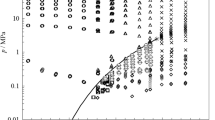Considering the importance of refining the fundamental equations of state for hydrocarbons, the authors discuss the methodological and design features of experimental measurement of isobaric heat capacity in the critical region by using the continuous-flow adiabatic calorimetry method. The pressure measurement system was improved by introducing a differential pressure gauge into the measuring circuit, which made it possible to not only increase the accuracy of the pressure determination, but also implement a universal scheme of the calorimetric experiment. The use of such universal scheme of the calorimetric experiment makes it possible to determine two values of isobaric heat capacity at pressures that differ by the value of pressure drop inside the calorimeter. Such approach in the critical region is important, since it provides a quite simple and reliable way to determine the value of the derivative of heat capacity over pressure, which is used to estimate not only the error of referencing the value of heat capacity to a certain pressure, but also the equilibrium conditions of the experiment in a continuous-flow calorimeter. The authors review the procedure for determining and correcting for inhomogeneity of the lead wires of the differential thermocouple, and for throttling the substance flow inside the calorimeter. Proper relationships were obtained for determining the average experimental temperature when utilizing various methods of measuring temperature and temperature difference in a continuous-flow calorimeter. The results of experimental measurements of isobaric heat capacity of n-pentane in the critical region are presented, which were obtained by using a universal scheme of the calorimetric experiment. For n-pentane, the measurements were performed at 3.400 MPa (critical pressure – 3.355 MPa), which is the closest to the critical point in the practice of flow calorimetry.





Similar content being viewed by others
References
M. A. Kuznetsov, E. B. Grigoriev, and S. I. Lazarev, “Caloric properties of hydrocarbons in liquid, gaseous, and supercritical states. N-heptane,” Teplofiz. Vys. Temp., 56, 4, 514–526 (2018), https://doi.org/10.1134/S0018151X18040119.
B. A. Grigoriev, I. S. Alexandrov, and A. A. Gerasimov, Fluid Phase Equil., 418, 15–36 (2016), https://doi.org/10.1016/j.fluid.2015.07.046.
I. S. Aleksandrov, A. A. Gerasimov, and B. A. Grigoriev, “A new fundamental equation of state of normal pentane,” Vesti Gaz. Nauki. Akt. Vopr. Issled. Plast. Sist. Mestorozhd. Uglevodor., No. 4(28), 87–95 (2016).
A. A. Gerasimov, I. S. Aleksandrov, and B. A. Grigoriev, “A new fundamental equation of state of normal hexane,” Vesti Gaz. Nauki. Akt. Vopr. Issled. Plast. Sistem Mestorozhd. Uglevodor., No. 1(33), 117–128 (2018).
A. M. Sirota, Study of the Caloric Properties of Water in a Wide Range of State Parameters (25–100 kgf/cm2, 0–700°C): Auth. Abstr. Dissert. Doct. Techn. Sci., All-Union Thermal Engineering Research Institute, Moscow (1970).
A. A. Gerasimov, Caloric Properties of Normal Alkanes and Multi-Component Hydrocarbon Mixtures in the Liquid and Gaseous Phases, Including the Critical Region: Dissert. Doct. Techn. Sci., MEI, Moscow (2000).
M. A. Kuznetsov, Scientific Basics for Forecasting and Calculating the Thermodynamic Properties of Hydrocarbons: Dissert. Doct. Techn. Sci., Voronezh State Technical University, Voronezh (2008).
M. A. Kuznetsov, “Modified calorimeter for measuring isobaric heat capacity of hydrocarbons in the critical region by a flow-through method,” Izmer. Tekhn., No. 8, 43–48 (2005).
B. A. Grigoriev (ed.), A. A. Gerasimov, and I. S. Aleksandrov, Thermophysical Properties of Petroleum Hydrocarbons, Gas Condensates, Natural and Fossil Gases, Izd. Dom MEI, Moscow (2019), Vol. 1.
V. E. Kharin, Calorical Properties of n-Pentane in the Liquid and Vapor Phases, Including the Critical Region: Dissert. Cand. Phys. Math, Sci., Kabardino-Balkarian State University, Nalchik (1988).
This study was sponsored by the Russian Foundation for Basic Research (projects 20-08-00167 and 20-08-00066).
Author information
Authors and Affiliations
Corresponding author
Additional information
Translated from Izmeritel’naya Tekhnika, No. 2, pp. 30–37, February, 2021.
Rights and permissions
About this article
Cite this article
Gerasimov, A.A., Grigoriev, B.A., Kuznetsov, M.A. et al. Measuring Isobaric Heat Capacity of Fluids in the Critical Region by Continuous-Flow Adiabatic Calorimetry Method. Meas Tech 64, 109–118 (2021). https://doi.org/10.1007/s11018-021-01904-6
Received:
Accepted:
Published:
Issue Date:
DOI: https://doi.org/10.1007/s11018-021-01904-6



